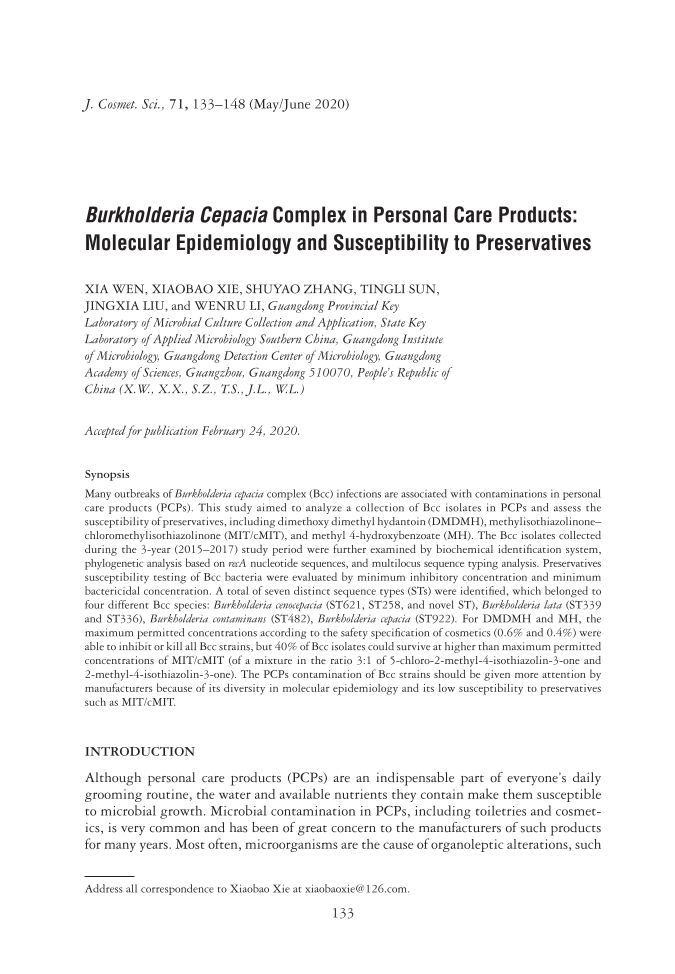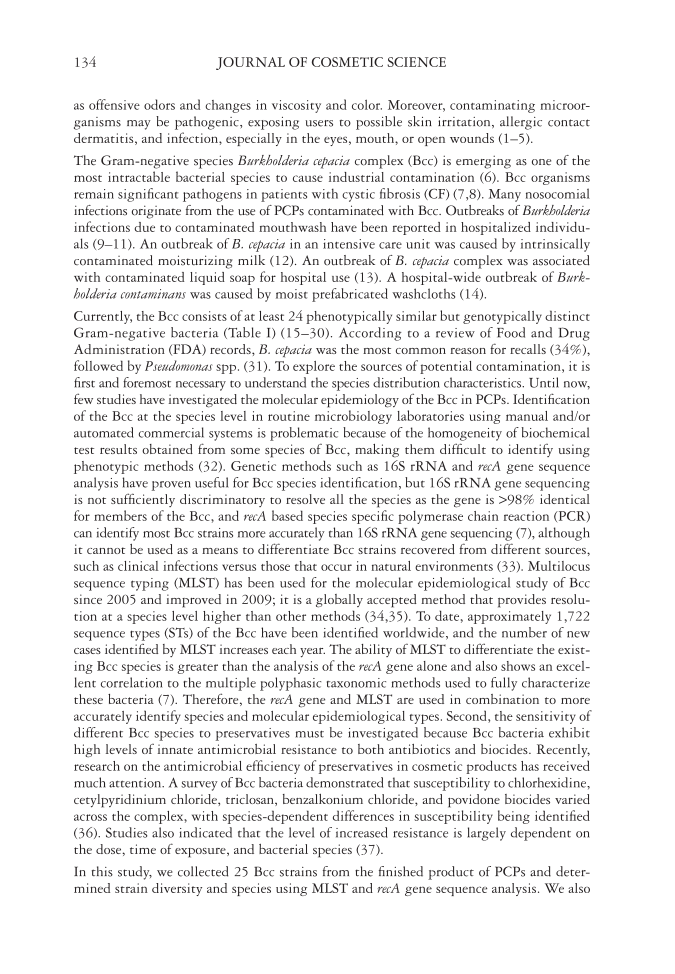J. Cosmet. Sci., 71, 133–148 (May/June 2020) 133 Burkholderia Cepacia Complex in Personal Care Products: Molecular Epidemiology and Susceptibility to Preservatives XIA WEN, XIAOBAO XIE, SHUYAO ZHANG, TINGLI SUN, JINGXIA LIU, and WENRU LI , Guangdong Provincial Key Laboratory of Microbial Culture Collection and Application, State Key Laboratory of Applied Microbiology Southern China, Guangdong Institute of Microbiology, Guangdong Detection Center of Microbiology, Guangdong Academy of Sciences, Guangzhou, Guangdong 510070, People’s Republic of China (X.W., X.X., S.Z., T.S., J.L., W.L.) Accepted for publication February 24, 2020. Synopsis Many outbreaks of Burkholderia cepacia complex (Bcc) infections are associated with contaminations in personal care products (PCPs). This study aimed to analyze a collection of Bcc isolates in PCPs and assess the susceptibility of preservatives, including dimethoxy dimethyl hydantoin (DMDMH), methylisothiazolinone– chloromethylisothiazolinone (MIT/cMIT), and methyl 4-hydroxybenzoate (MH). The Bcc isolates collected during the 3-year (2015–2017) study period were further examined by biochemical identifi cation system, phylogenetic analysis based on recA nucleotide sequences, and multilocus sequence typing analysis. Preservatives susceptibility testing of Bcc bacteria were evaluated by minimum inhibitory concentration and minimum bactericidal concentration. A total of seven distinct sequence types (STs) were identifi ed, which belonged to four different Bcc species: Burkholderia cenocepacia (ST621, ST258, and novel ST), Burkholderia lata (ST339 and ST336), Burkholderia contaminans (ST482), Burkholderia cepacia (ST922). For DMDMH and MH, the maximum permitted concentrations according to the safety specifi cation of cosmetics (0.6% and 0.4%) were able to inhibit or kill all Bcc strains, but 40% of Bcc isolates could survive at higher than maximum permitted concentrations of MIT/cMIT (of a mixture in the ratio 3:1 of 5-chloro-2-methyl-4-isothiazolin-3-one and 2-methyl-4-isothiazolin-3-one). The PCPs contamination of Bcc strains should be given more attention by manufacturers because of its diversity in molecular epidemiology and its low susceptibility to preservatives such as MIT/cMIT. INTRODUCTION Although personal care products (PCPs) are an indispensable part of everyone’s daily grooming routine, the water and available nutrients they contain make them susceptible to microbial growth. Microbial contamination in PCPs, including toiletries and cosmet- ics, is very common and has been of great concern to the manufacturers of such products for many years. Most often, microorganisms are the cause of organoleptic alterations, such Address all correspondence to Xiaobao Xie at xiaobaoxie@126.com.
JOURNAL OF COSMETIC SCIENCE 134 as offensive odors and changes in viscosity and color. Moreover, contaminating microor- ganisms may be pathogenic, exposing users to possible skin irritation, allergic contact dermatitis, and infection, especially in the eyes, mouth, or open wounds (1–5). The Gram-negative species Burkholderia cepacia complex (Bcc) is emerging as one of the most intractable bacterial species to cause industrial contamination (6). Bcc organisms remain signifi cant pathogens in patients with cystic fi brosis (CF) (7,8). Many nosocomial infections originate from the use of PCPs contaminated with Bcc. Outbreaks of Burkholderia infections due to contaminated mouthwash have been reported in hospitalized individu- als (9–11). An outbreak of B. cepacia in an intensive care unit was caused by intrinsically contaminated moisturizing milk (12). An outbreak of B. cepacia complex was associated with contaminated liquid soap for hospital use (13). A hospital-wide outbreak of Burk- holderia contaminans was caused by moist prefabricated washcloths (14). Currently, the Bcc consists of at least 24 phenotypically similar but genotypically distinct Gram-negative bacteria (Table I) (15–30). According to a review of Food and Drug Administration (FDA) records, B. cepacia was the most common reason for recalls (34%), followed by Pseudomonas spp. (31). To explore the sources of potential contamination, it is fi rst and foremost necessary to understand the species distribution characteristics. Until now, few studies have investigated the molecular epidemiology of the Bcc in PCPs. Identifi cation of the Bcc at the species level in routine microbiology laboratories using manual and/or automated commercial systems is problematic because of the homogeneity of biochemical test results obtained from some species of Bcc, making them diffi cult to identify using phenotypic methods (32). Genetic methods such as 16S rRNA and recA gene sequence analysis have proven useful for Bcc species identifi cation, but 16S rRNA gene sequencing is not suffi ciently discriminatory to resolve all the species as the gene is 98% identical for members of the Bcc, and recA based species specifi c polymerase chain reaction (PCR) can identify most Bcc strains more accurately than 16S rRNA gene sequencing (7), although it cannot be used as a means to differentiate Bcc strains recovered from different sources, such as clinical infections versus those that occur in natural environments (33). Multilocus sequence typing (MLST) has been used for the molecular epidemiological study of Bcc since 2005 and improved in 2009 it is a globally accepted method that provides resolu- tion at a species level higher than other methods (34,35). To date, approximately 1,722 sequence types (STs) of the Bcc have been identifi ed worldwide, and the number of new cases identifi ed by MLST increases each year. The ability of MLST to differentiate the exist- ing Bcc species is greater than the analysis of the recA gene alone and also shows an excel- lent correlation to the multiple polyphasic taxonomic methods used to fully characterize these bacteria (7). Therefore, the recA gene and MLST are used in combination to more accurately identify species and molecular epidemiological types. Second, the sensitivity of different Bcc species to preservatives must be investigated because Bcc bacteria exhibit high levels of innate antimicrobial resistance to both antibiotics and biocides. Recently, research on the antimicrobial effi ciency of preservatives in cosmetic products has received much attention. A survey of Bcc bacteria demonstrated that susceptibility to chlorhexidine, cetylpyridinium chloride, triclosan, benzalkonium chloride, and povidone biocides varied across the complex, with species-dependent differences in susceptibility being identifi ed (36). Studies also indicated that the level of increased resistance is largely dependent on the dose, time of exposure, and bacterial species (37). In this study, we collected 25 Bcc strains from the fi nished product of PCPs and deter- mined strain diversity and species using MLST and recA gene sequence analysis. We also
Purchased for the exclusive use of nofirst nolast (unknown) From: SCC Media Library & Resource Center (library.scconline.org)











































































